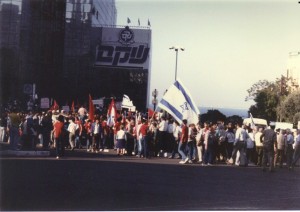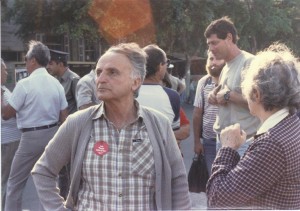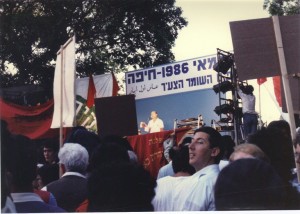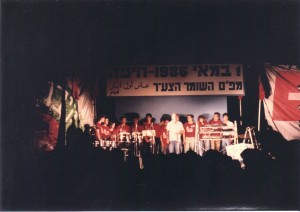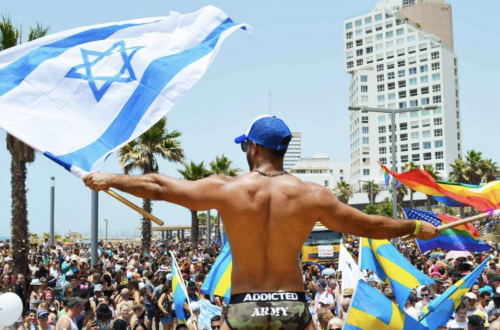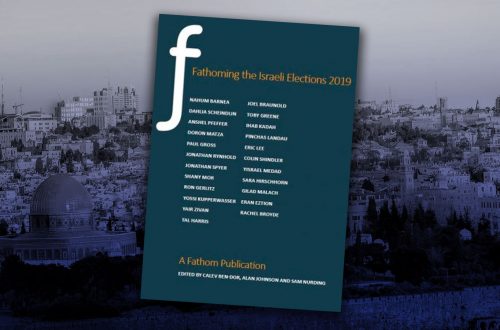Following up on Sarah’s post, here are some photos I took when I stumbled onto a May Day demonstration, sponsored by the leftwing Zionist party Mapam (now merged into Meretz) and the affiliated kibbutz/youth movement Hashomer Hatzair, on my first visit to Israel. (Click to enlarge.)
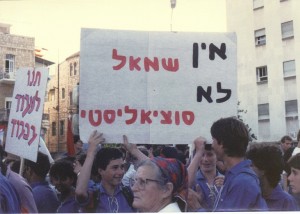
The sign says “There isn’t a non-socialist Left.”
The demonstration concluded with the singing of “The Internationale” and the Israeli national anthem “HaTikvah.”
Update: Ronnie Fraser provides a fascinating report from the labour attaché at the British embassy in Tel Aviv on May Day activities in Israel in 1955– when apparently it was a really big deal:
The International Labour Day celebrations in Israel yesterday passed off fairly uneventfully. There were parades in numerous towns as far south as Beersheba but the major events were, of course, in Tel Aviv, Haifa and Jerusalem. The turnout at Haifa, which is the main Industrial centre of the country, was estimated at 45,000 and in Tel Aviv at about 30,000. At the invitation of the Histadrut, the American Labour Attaché and I were on the platform in Tel Aviv to watch the march-past.
On this occasion there had been agreement beforehand that the various Parties represented in the Histadrut should combine in one single parade instead of having the factional demonstrations which have occurred on some previous occasions. There was also agreement about the wording of the slogans which might be used by the various Parties and that no other slogans would be used in the procession. In the event, the political section of the Tel Aviv parade comprised 130 members each of Mapai, L’Ahdut Ha’Avodah and Mapam. It was not clear beforehand how far the Communists would be represented, but they turned up in the middle of the procession. I shall refer to them again in a moment. As might have been expected, the General Zionists, although they are putting up their own lists for the first time in the Histadrut elections this year, were not represented in the parade. This is, of course, a logical manifestation of their beliefs but it had been thought in some quarters that they might, nevertheless, put in an appearance in order to publicise themselves within the Histadrut movement in preparation for next Sunday’s elections.The form of the Tel Aviv procession followed the usual lines. At the head were the Minister of Labour (Mrs. Golda Myerson), the Secretary-General of the Histadrut and those members of its Executive Bureau who were not guests in other towns. These dignitaries left the procession when they reached the platform where they joined the visitors to watch the parade for nearly three-and-a- half hours.
The political contingents which I have mentioned above were followed by groups and “floats” representing various trades and industries and the numberless co-operatives within the Histadrut organisation. Then came a very long succession of contingents from the various kibbutzim and youth movements affiliated to the working class movement. In fact, the purely trade union elements of the parade were quite dwarfed by the emphasis on youth and the colonisation of the land, especially the Negev. The atmosphere was in fact distinctly Israeli. Finally, the procession was rounded off by a series of floats staged by Solel Boneh, the large Histadrut enterprise which started off as the organisation’s building and contracting organisation but which now has its finger in all sorts of industrial pies.
There was a substantial public turnout to witness the procession and the streets were alive with Israel national flags and red flags. The latter seem to have caused some consternation to some of the visiting American ladies in the town and on more than one occasion I heard people explaining to them very patiently that the red flag was the universal symbol of working-class movements long before its special association with the Communist Party. There was, however, little in the way of significant events or features. There was some surprise on the platform to find the contingent of the local Communist Party in the middle of the parade since people expected to find it, if at all, either in the political section at the front or near the end. I was later informed, however, that at some point this body had forced itself into the middle of the parade and the organisers had not thought it worthwhile to risk unpleasant incidents but had allowed them to carry on (the word “forced” is perhaps not altogether appropriate since there were frequent long gaps in the procession and I should not think the Communists would have had much difficulty in infiltrating into a position which suited them. I was interested to note three Arabs in the Mapam section of the procession and, at a later stage, there was quite a sprinkling of Arabs in various youth and similar groups but, again, mostly in those affiliated to Mapam. One or two of the young people’s groups did in fact call out slogans which had not been agreed beforehand and, in particular, the usual sort of references to the “bourgeoisie”. A Histadrut official remarked to me that probably no two of them had the same definition of this overworked word.
The parades in Haifa and Jerusalem seem to have been carried out on very similar lines but there was in each case a minor incident which may be worth mentioning. In Jerusalem the Mapam delegation from the Corridor called out “Long Live Peace, Long Live the U.S.S.R.” as they strode past carrying red flags topped with Picasso doves. In Haifa, when the Mayor, the Secretary of the local Labour Council and other local dignitaries took their seats the stage collapsed. No-one was hurt. Later, when the Communist contingent reached what was left of the stage they unfurled their own slogans, Mr, Almogi, Secretary of the Haifa Labour Council, and a tough customer by any standards, ordered the blue-shirted ushers to take them down. Within a few
minutes and after a few blows, the offending slogans were removed.
